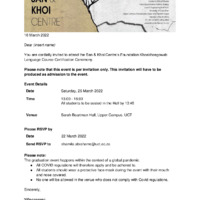Opening ritual: Foundation Khoekhoegowab Language Course Graduation 2022
by https://ibali.uct.ac.za/s/library-history/item/33321
The use of indigenous knowledge systems and keeping centuries old traditions alive was a central focus of the graduation ceremony. In the opening ceremony, Bradley- along with ceremony practitioners, Kirsten Fisher and Timotheus Maasdorp- burned the traditional impepo herbs, renosterbos and snake bush. These are companion herbs and are found in the eastern facing slopes of the //Hui !Gaeb mountain. The act of burning medicine is a transformative bridging process with the smoke of the burning herbs marking a transition into the spirit realm, the unseen, with the physical world, the seen, says Bradley. The burning of the herbs and the smoke was a way of welcoming the participants of the ceremony into the space with Bradley, Kirsten and Timotheus walking in a circular formation around the hall. The circle is a powerful motif as it is associated with the patterns of life and nature and is intrinsically interwoven into the culture and cosmology of the Khoe and San people. By moving around the space in such a powerful way with the clouds of smoke, a safe space was created for the procession of the ceremony to take place. The circular movement was also a way of opening a ritualistic ceremonial portal for the ancestors to be welcomed into the space. The Kudu horns acted as antennas with one horn transmitting and the other horn receiving- the horns became an object of facilitating the communication with the ancestors between the realms of the physical world and the spiritual world. The act of the ritual was a way of remembering and honouring the ancestors, family lineages and knowledge lineages that came before with the “We are Beginning” song sung in Khoekhoegowab. The notion of beginnings was a strong presence felt in the ceremony as it was a powerful occasion of many historical firsts.






